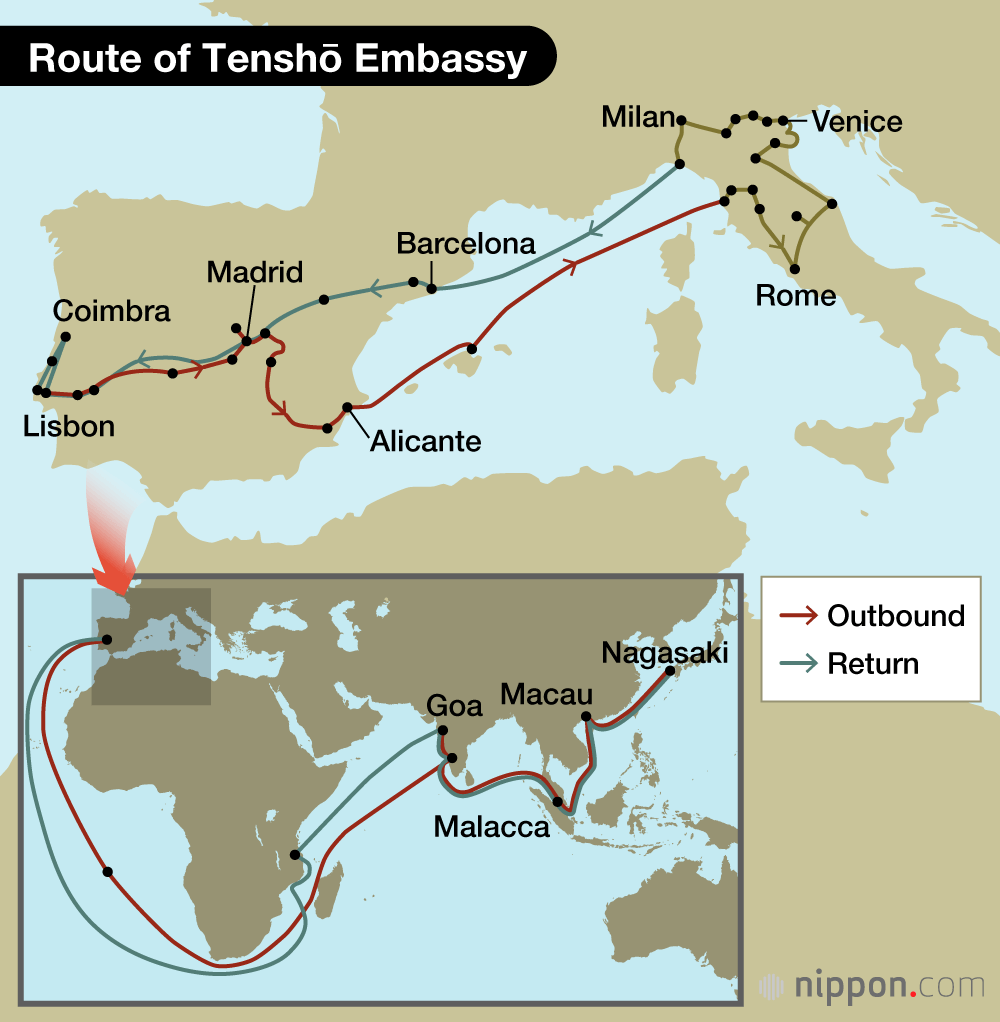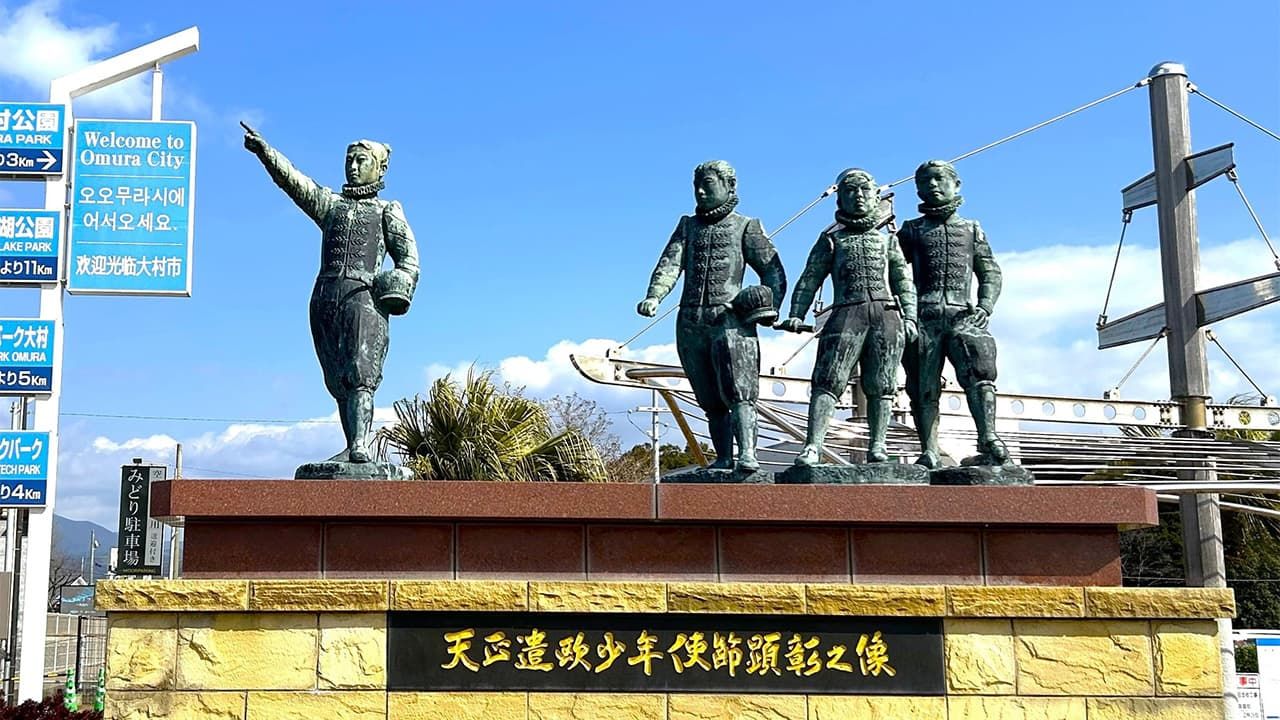
Nagasaki Sites Associated with Endō Shūsaku’s “Silence”
Early Christianity in Japan: Retracing the Life of Sixteenth-Century Emissary to Rome Chijiwa Miguel
History Culture World Guide to Japan- English
- 日本語
- 简体字
- 繁體字
- Français
- Español
- العربية
- Русский
Journey to Rome
In February 1582, four Japanese youths left Nagasaki bound for Europe as part of the Tenshō embassy. The diplomatic mission, among the first recorded accounts of Japanese in Europe, was initiated by Alessandro Valignano, an Italian Jesuit priest who accompanied the young emissaries Itō Mancio, Chijiwa Miguel, Hara Martinho, and Nakaura Julião—all aged just 13 or 14—on their journey half-way around the globe.
Studying at a Jesuit seminary in Arima on the Shimabara Peninsula (today part of Nagasaki Prefecture), the young men had been instructed in subjects ranging from Latin to astronomy to Western music. In Europe, the young Christians travelled to Portugal, Spain, and Italy, where they met with leading cultural figures and rulers and had an audience with two Popes. Below is a brief introduction of the four Tenshō envoys.
Itō Mancio (senior envoy)
Born in 1569 in Hyūga province (Miyazaki Prefecture), he was the grandson of daimyō Itō Yoshisuke. He was eight years old when Yoshisuke was defeated by the Shimazu clan and sought refuge with the Christian daimyō Ōtomo Sōrin of Bungo province (Ōita Prefecture), who would later help sponsor the Tenshō mission.
Chijiwa Miguel (senior envoy)
Born in 1569 in Hizen province (Nagasaki Prefecture). He was four years old when his military commander father Chijiwa Naokazu was defeated by the Ryūzōji clan, forcing he and his mother to take refuge with his uncle, the Christian daimyō Ōmura Sumitada. He was one of the first students at the Jesuit seminary in Arima.
Hara Martinho (deputy envoy)
The only known documents of his birth come from Italy, which indicate he was born around 1569 in Hasami in Hizen province to Hara Nakatsukasa, a prominent figure in the Ōmura domain. He is considered to have been the brightest of the four ambassadors.
Nakaura Julião (deputy envoy)
Records kept by Jesuits in Rome indicate he was born in 1568 in Hizen province to Kozasa Sumiyoshi, the lord of Nakaura Castle. After his father was killed in battle, he came under the patronage of Ōmura Sumitada’s son Koshō.
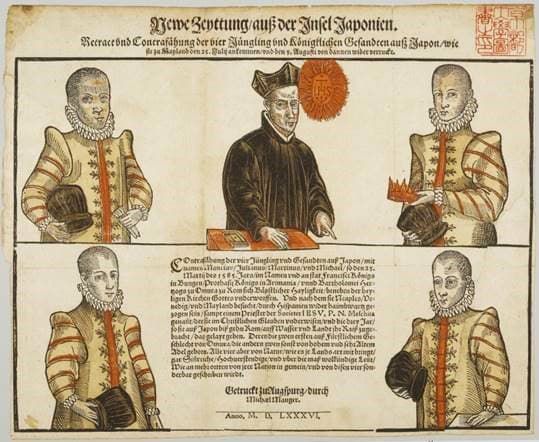
A newspaper printed in the Bavarian city of Augsburg in 1586 depicts the members of the Tenshō embassy. Clockwise from top left: Nakaura Julião, Father Diogo de Mesquita, Itō Mancio, Chijiwa Miguel, and Hara Martinho. (Courtesy Kyoto University)
Sailing eastward, the embassy grappled with rough seas, unfavorable winds, and outbreaks of disease that required it to stop, sometimes for months on ends, in different ports as it slowly made its way to Europe. It touched at Macau, Malacca, and Goa before rounding the Cape of Good Hope, finally reaching Lisbon on August 10, 1584, some two and a half years after leaving Nagasaki.
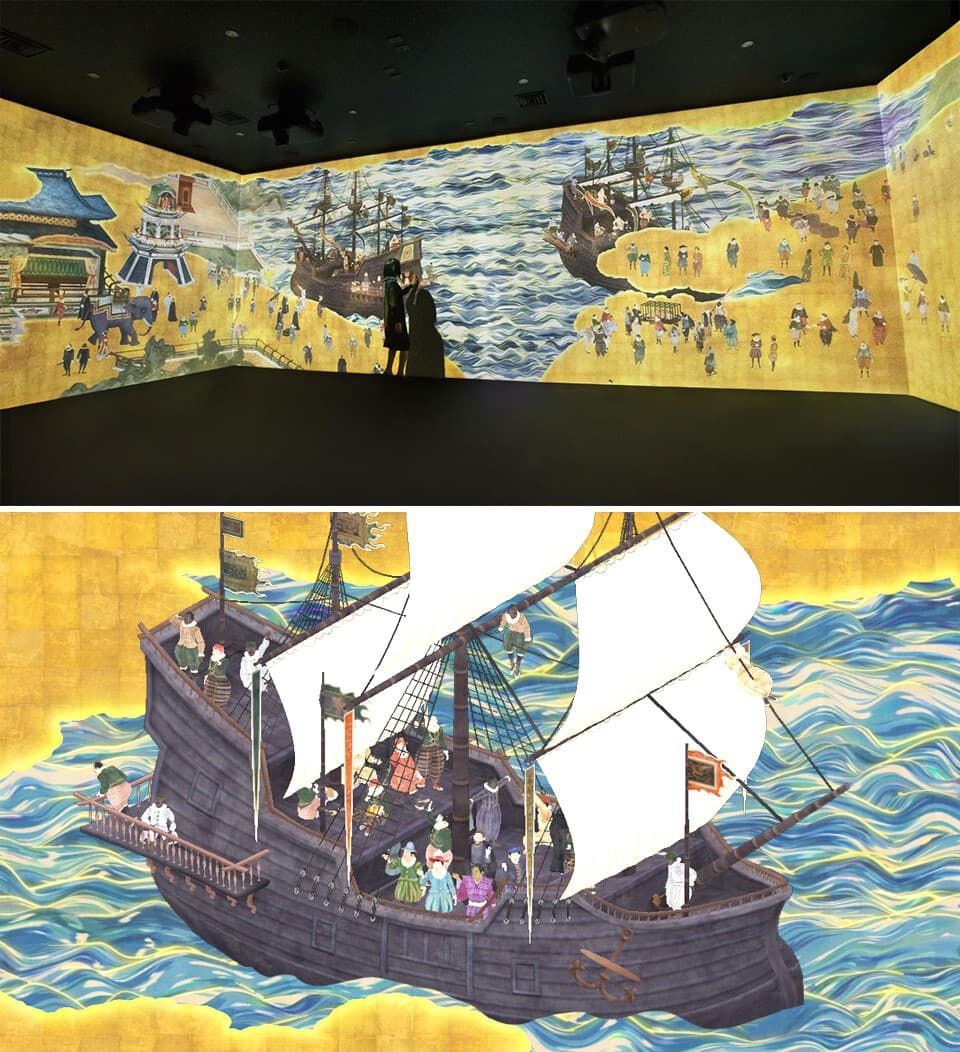
A digital exhibit at the Ōmura City History Museum retraces the route taken by the Tenshō embassy on its journey to Europe. (© TeamLab)
European Impressions
The Tenshō embassy officially represented Ōtomo, Ōmura, and Arima Harunobu, the three most important Christian daimyō, and carried letters from them to the pope. However, the impetus for the mission was wholly Valignano’s, who conceived of it with two main objectives in mind.
First, he wanted to introduce Japan to Europeans, reasoning that the sight of the young Japanese would help win the support and financial backing of the pope and the king of Spain and Portugal for further Jesuit missionary work in East Asia. Second, he wanted to impress on the emissaries the grandeur and authority of the Christian religion in Europe in expectation that they would report this when they returned home, raising the stature of Christianity in Japan and helping in its spread.
There was the risk that Europeans, who knew almost nothing about far-away Japan, would look down their noses at the foreigners, and Valignano went to great pains to groom the Japanese youths to conduct themselves in a “cultured” fashion. Certainly, there were some who treated the four as exotic oddities, but most accounts describe the ambassadors as fulfilling their diplomatic duties with aplomb.
From Lisbon, the embassy made its way to Spain, stopping at cities along the way before reaching Madrid, where it was met warmly by Philip II. The king of Spain and Portugal, Philip ruled over a vast, global empire that made him the most powerful ruler in Europe next to the pope in Rome. He was impressed by the resolve and intelligence of the boys and sent letters to the mayors and administrators of the cities along their route ordering that the envoys be welcomed and provided with any funds and support they required.
The embassy triumphantly made its way to Rome, where Pope Gregory XIII received it at Saint Peter’s Basilica with all the ceremony fitting an official mission. Pope Gregory died shortly after, but his successor Sixtus V was equally welcoming of the mission, inviting the four envoys to take part in the procession to the Archbasilica of Saint John Lateran following his selection. A fresco in the Sistine Hall of the Vatican Library captures the scene and shows the young Japanese emissaries astride white horses.
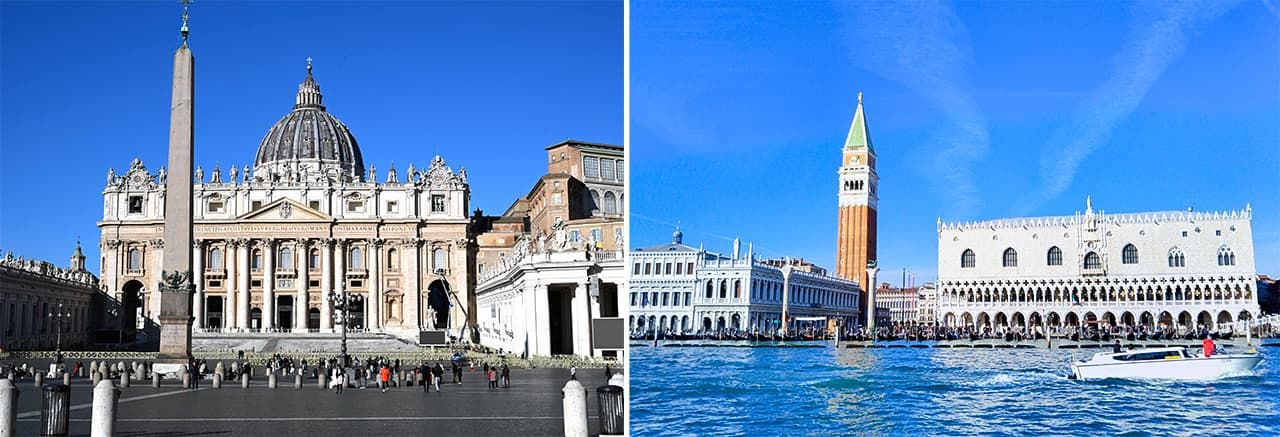
From left: Saint Peter’s Basilica, where the embassy had its audience with Pope Gregory XIII. (© Reuters); the delegation also visited Venice, with records describing the waters next to the city’s Piazza San Marco filled with boats in welcome of the Japanese emissaries. (© Amano Hisaki)
Shifting Tides
Having succeeded in its mission after more than a year and a half in Europe, the Tenshō embassy began the long journey home in April 1586. However, the situation awaiting them in Japan had changed dramatically. Landing in Macau in August 1588 the mission learned that warlord Toyotomi Hideyoshi had issued an edict the previous year expelling Christian missionaries from Japan. Concerned, the members of the embassy pushed on, reaching Nagasaki in July 1590 after eight and a half years away.
Some time later, the four emissaries and Valignano were summoned by Hideyoshi to his Jurakudai Palace in Kyoto to give an account of their journey. Portuguese Jesuit missionary Luís Fróis describes in his book History of Japan how among the tributes offered to the warlord, Hideyoshi prized the gift of Arabian horses, with a demonstration of Western equestrian techniques by the Portuguese handlers of the animals making a deep impression.
There was no shifting the growing anti-Christian tide, though. Hideyoshi and his successor Tokugawa Ieyasu issued a string of edicts against the religion, and persecution of missionaries and followers of the faith increased. Droves of believers in strongholds like Nagasaki, Ōmura, and Shimabara were forced to recant or died for their faith.
Of the four Tenshō emissaries, Itō Mancio, Hara Martinho, and Nakaura Julião were ordained Jesuit priests in Japan. Itō, the leader of the delegation to Europe, carried out missionary work in Kyūshū and the Chūgoku region in western Honshū until his death from disease in 1612. Hara, who was a linguistic prodigy, fled to Macao as persecution intensified, teaching and translating there until his death in 1629. Nakaura remained in Japan and continued his missionary activities even as persecution of Christians intensified, dying a martyr in 1633.

The ruins of Saint Paul’s Cathedral in Macao. Hara Martinho is said to be buried at the altar of a church in the historic district of the city, which is a World Heritage site. (© Pixta)
The remaining member of the mission, Chijiwa Miguel, entered the Jesuit order like his colleagues, but left sometime between 1601 and 1603. He eventually abandoned the Christian religion, and history remembers him as an apostate.
Extraordinary Discovery
What little is known about Chijiwa’s life after returning to Japan provides no clues as to why he turned from Christianity. After leaving the Jesuits, he took Seizaemon as his given name and served Ōmura Sumitada’s successor Yoshiaki before fleeing the domain after the daimyō banned Christianity in 1606. He spent time in Arima and Nagasaki, married, and fathered four children, but it was not known when and where he died.
Then in 2003, researcher Miyazaki Eiichi came across a grave in Ikiriki, a village in Isahaya in central Nagasaki Prefecture, purported to belong to Chijiwa Miguel’s fourth son Genba. He reached out to fellow researcher Ōishi Kazuhisa, a local high school teacher and expert on stonework, and encouraged him to have a look.
Miyazaki had been digging through Ōmura domain records piecing together the Chijiwa line—he had uncovered that Ōishi was distantly related to Genba on his mother’s side—and sharing his findings in the newsletter of the local historical society. Despite the genealogical connection, Ōishi showed little interest in visiting the site at first as experience told him that grave markers from the Edo period (1603–1868) generally were of a design mandated by the shogunal government and offered few historical clues.
Ōishi finally visited the grave with Miyazaki three months later. Speaking with Ide Norimitsu, a local who had long tended the grave, he learned that the site had been revered for generations as Genba’s resting place. However, all that Ōishi found on the face of the marker were two posthumous Buddhist names and a date corresponding to 1633.
Suspecting that the story of it being Genba’s grave was a local legend, he inspected the reverse side of the gravestone and found something that seemingly proved the claim. There carved in the stone was the name Chijiwa Genba.
But Ōishi knew better. It was customary with old gravestones for the name of the chief mourner to be carved at the back, indicating that Genba was the sponsor of the tomb, not the inhabitant. The early date also made it unlikely that Genba was buried there. Of equal interest was the fact that the grave contained a couple. The two individuals interred were likely family members, raising the probability that it was Chijiwa Miguel and his wife, an exciting proposition.
Ide added credence to the theory, saying that family lore held that the occupant of the grave had a grudge against the Ōmura domain and had been buried where he could “keep an eye on things.” If true, this further reduced the odds of it being Genba, who records show was adopted into the Ōmura clan and lived within the confines of nearby Kushima Castle.
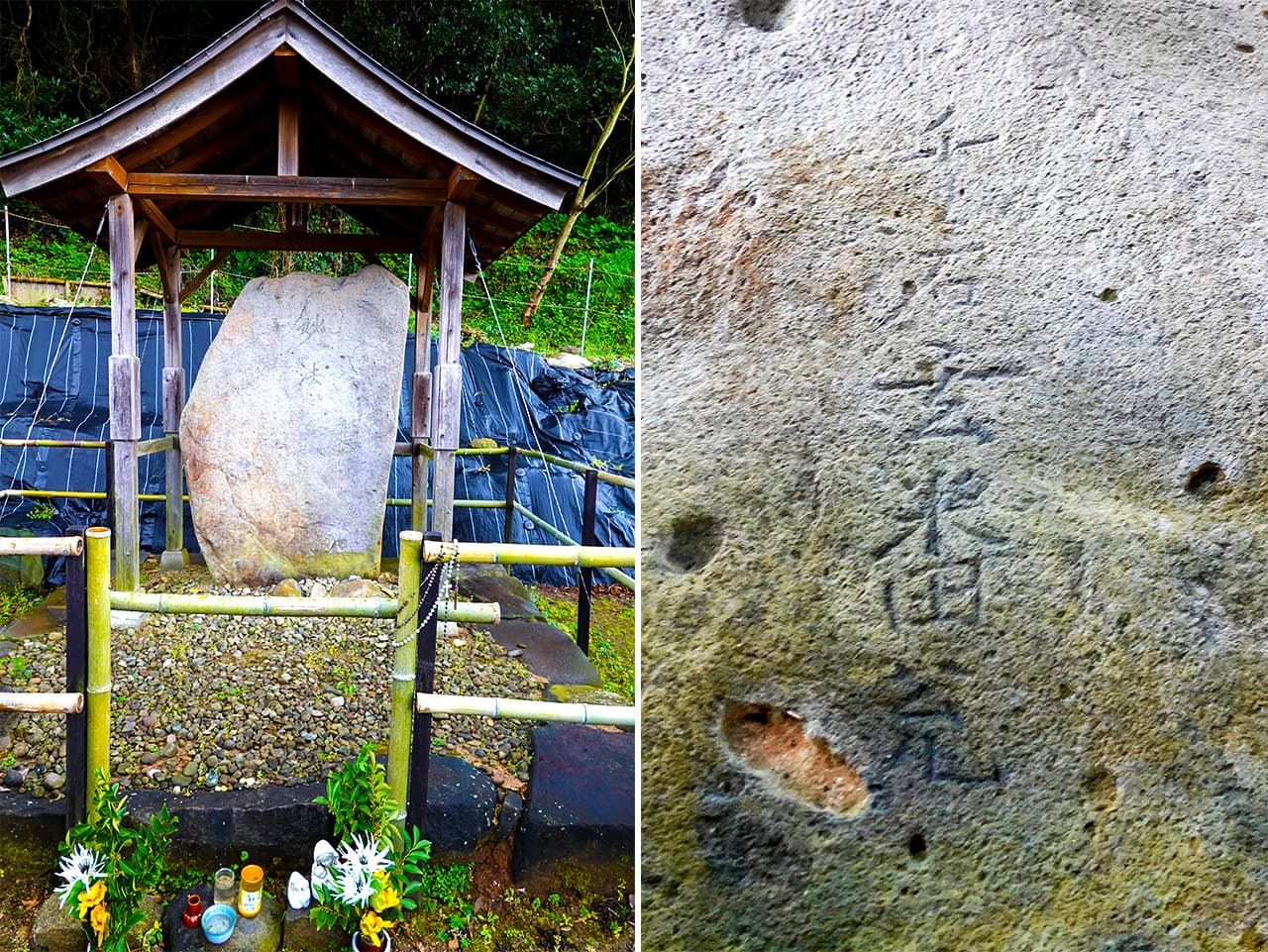
From left: The grave sets on a hill in Ikiriki overlooking Ōmura Bay; the name Chijiwa Genba no jō engraved at the back of the gravestone. (© Amano Hisaki)
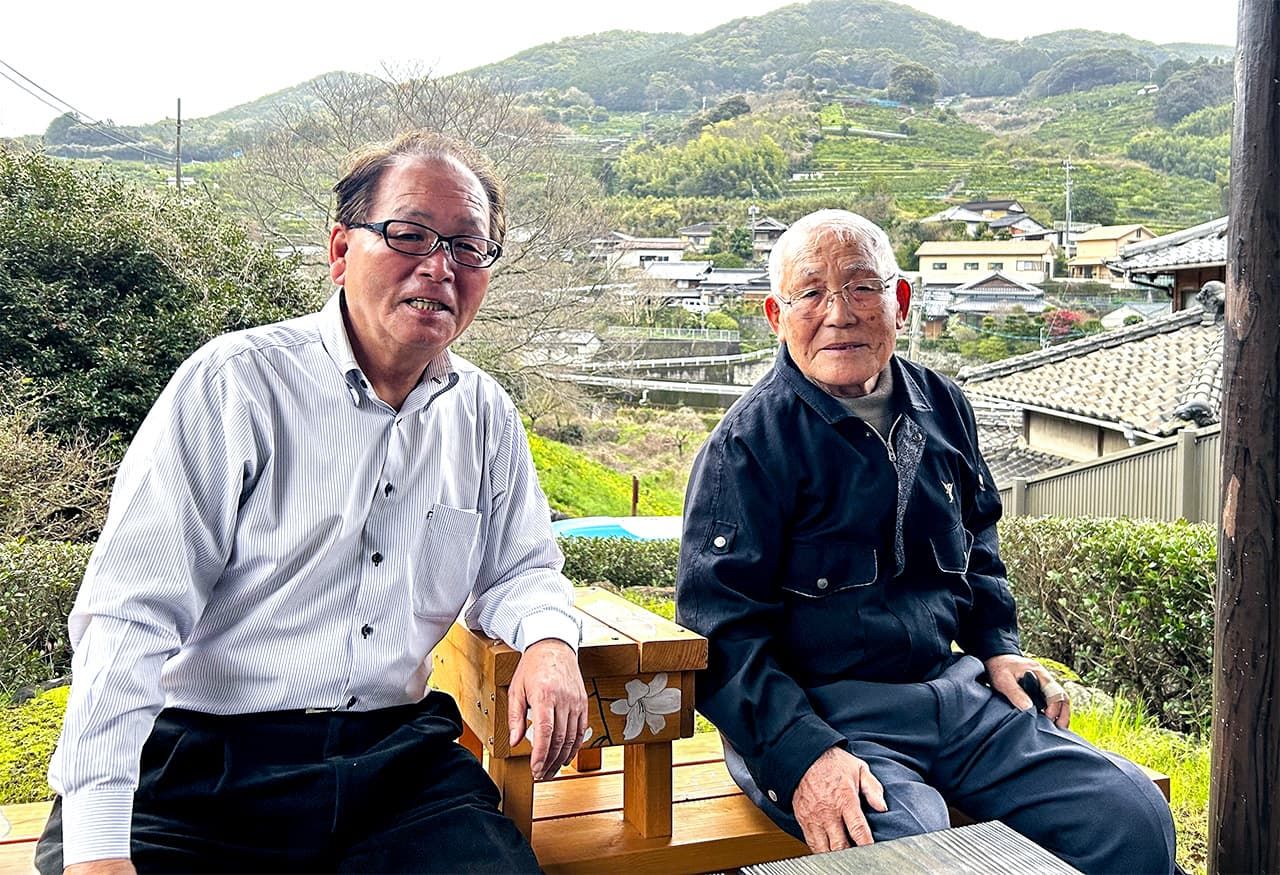
Ōishi Kazuhisa (left) and caretaker Ide Norimitsu. (© Amano Hisaki)
Unraveling a Mystery
The only way to be certain that the grave belonged to Chijiwa Miguel was to carry out more research, including scouring Ōmura domain records to determine what if any connection Genba had to the Ikiriki site. Ōishi was able to make a link through an important Ōmura vassal, giving him the certainty he needed to announce the discovery to the press, which he did in 2004. He was careful to avoid reaching any definitive conclusions, though—that would require carrying out an excavation.
There have been four separate digs at the site, and the latest in 2021 unearthed the skeletal remains of a man and woman along with a slew of artifacts. Among the items of interest are burial goods such as beads and pieces of glass that are associated with Christian graves. Combined with other research, the findings make a strong case that the site is the final resting place of Chijiwa Miguel.
The discovery of a grave of one of the Tenshō emissaries would be of incredible historical importance. But the strong evidence that Chijiwa received a Christian burial is of immense significance as it rewrites history by overturning the label of apostate and proving that he had in fact retained his faith to the very end of his life.
(Originally published in Japanese. Banner photo: A monument to the four young members of the Tenshō embassy at Morizono Park in Ōmura commemorating the 400th anniversary of the diplomatic mission. © Amano Hisaki.)

